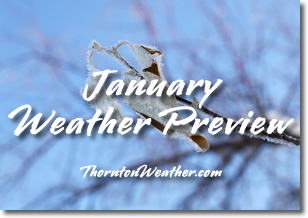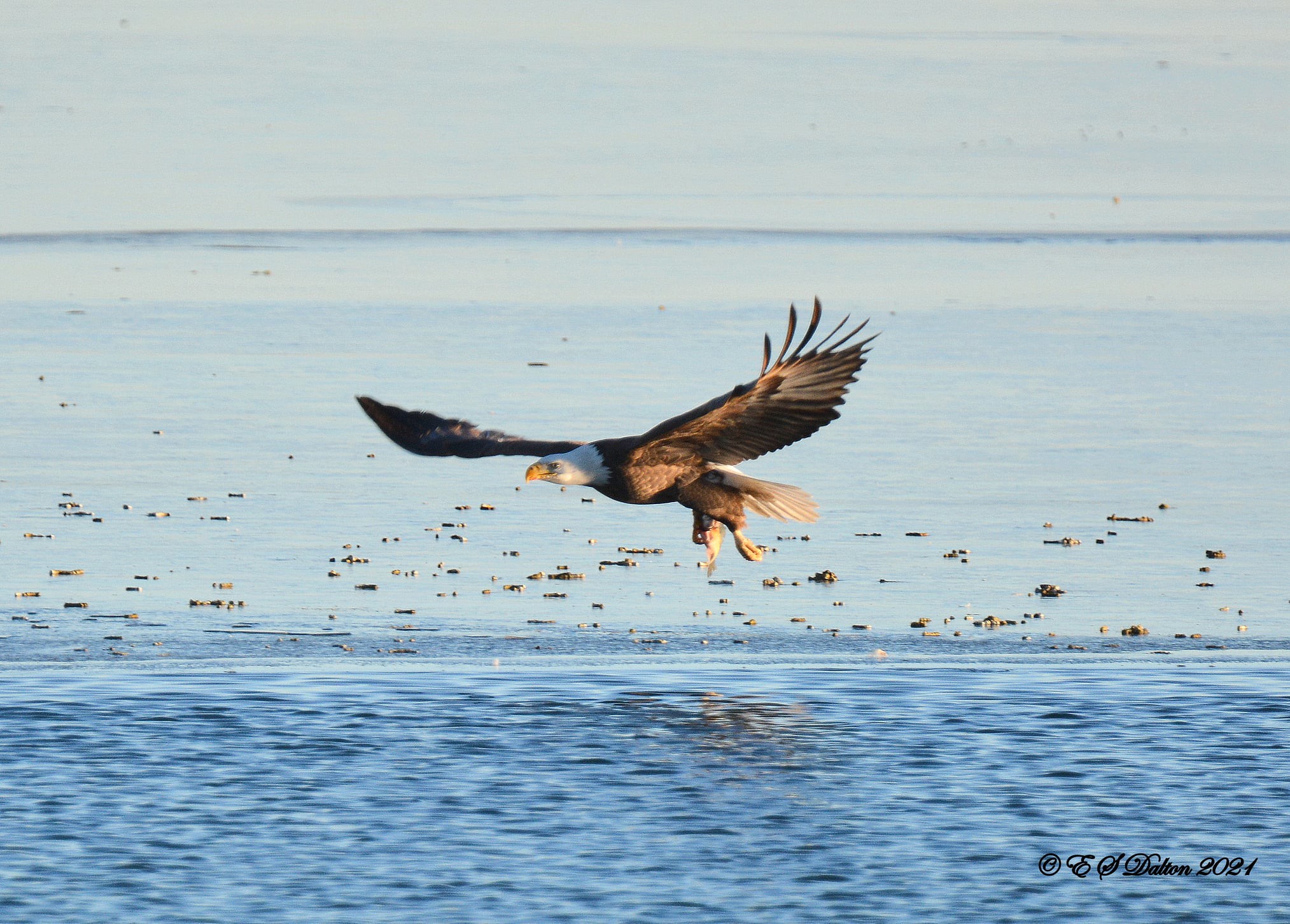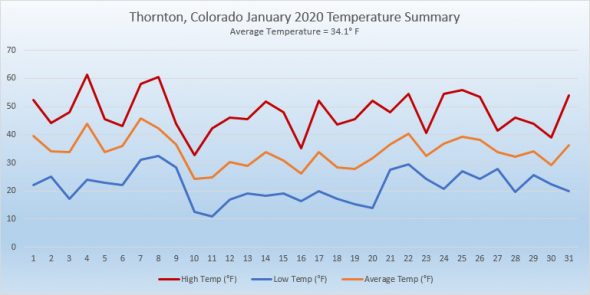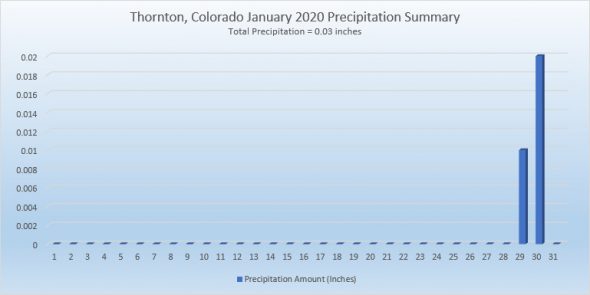
Winds can be a blessing and a curse this time of year. Chinook winds can help warm what is otherwise a normally chilly season. They can also cause a great deal of damage as they pick up speed as they come roaring across the Front Range. While we have been lucky thus far this year and not had damaging wind events, looking back at this week in Denver weather history one can’t help but think that maybe it is just a matter of time before they strike.
26-1
In 1888…a protracted warm spell lasted a week. Maximum temperatures ranged from 62 degrees on the 29th to an all time record high for the month of 76 degrees on the 27th. Daily record high temperatures of 76…69…and 71 occurred on the 27th…28th…and 30th respectively. Record high minimum temperatures of 47 and 34 occurred on the 26th and 27th.
27-31
In 1951…a major storm dumped 10.1 inches of snowfall at Stapleton Airport. Most of the snow…8.3 inches…fell on the 29th. Cold arctic air accompanied the snow. Several temperature records were set…including record low maximum temperatures of 4 on the 28th and 4 below zero on the 29th and record low temperatures of 12 below zero on the 29th and 24 below zero on the 31st. Temperatures were below zero for 45 consecutive hours.
29-31
In 1883…a major winter storm dumped 19.3 inches of snow on downtown Denver. Most of the snow…12.2 inches…fell on the 31st. This was the heaviest snowfall to hit the city in years. Temperatures plunged from a high of 52 degrees on the 29th to a low of 13 degrees on the 31st. Precipitation from the storm totaled 2.23 inches. The 1.22 inches of precipitation on the 31st was the greatest calendar day and 24 hour precipitation ever recorded in the city during the month of January.
30-31
In 1908…an apparent strong cold front plunged temperatures 45 degrees in 24 hours from 47 degrees at noon on the 30th to only 2 degrees at noon on the 31st. North winds were sustained to 30 mph on the 30th. Snowfall was only 0.8 inch on the 31st.
In 1965…a major storm dumped 10.4 inches of snow over metro Denver. After 5 inches of snow fell in Boulder… Strong Chinook winds developed…warming the temperature 25 degrees in 90 minutes. Wind gusts to 97 mph were recorded on Table Mountain in Boulder. Winds gusts to 53 mph were measured in downtown Boulder where some damage occurred. Minor wind damage also occurred in western suburbs of Denver. West winds gusted to 51 mph at Stapleton International Airport on the 31st.
In 2005…a winter storm brought heavy snow to the Front Range foothills. Storm totals included: 17 inches at Aspen Springs…13 inches 7 miles southwest of Boulder and at Lake Eldora…12.5 inches near Blackhawk…11.5 inches at Rollinsville and near Nederland…11 inches near Evergreen and Golden and at Gross Reservoir…and 10 inches at Cabin Creek. Lesser amounts of snow fell over the city. Only 1.9 inches of snow were measured overnight at Denver Stapleton. North winds gusted to 30 mph at Denver International Airport…where freezing fog during the early morning of the 30th reduced the surface visibility to as low as 1/8 mile. Light rainfall… Rare in January…totaled 0.06 inch at Denver Stapleton on the early morning of the 30th.
30-7
In 1985…a cold front on the 29th produced a protracted cold spell as arctic air remained entrenched across metro Denver. While the only daily temperature record set was a low maximum reading of 2 degrees on February 3rd…minimum temperatures plunged well below zero on 9 consecutive days. The coldest readings were 15 degrees below zero on January 31st and 14 degrees below zero on February 5th.
31
In 1876…hurricane force winds caused some damage in Boulder.
In 1951…the low temperature plunged to 24 degrees below zero.
In 1933…snowfall was 0.2 inch in downtown Denver. This was the only measurable snowfall of the month and resulted in 0.01 inch of melted snow…the only measurable precipitation of the month.
In 1964…high winds blew down a sidewalk cover where a building was under construction…injuring a young woman. Three men were injured when a brick wall at a construction site toppled on them. All were treated for face…leg…and neck injuries. A west-northwest wind gust to 47 mph was recorded at Stapleton International Airport.
In 1969…high winds struck Boulder with gusts to 115 mph recorded at the National Center for Atmospheric Research and 83 mph in downtown Boulder. Schools were closed because of danger from flying debris. Some damage and minor injuries occurred. Northwest winds gusted to 35 mph at Stapleton International Airport.
In 1985…bitterly cold weather froze pipes and cars and forced some schools to close across metro Denver. Minimum temperatures dipped to as low as 15 below to 20 below zero across metro Denver. The low temperature was 15 below zero at Stapleton International Airport.
31-1
In 1963…high winds struck metro Denver. The strong Chinook winds reached 101 mph in Littleton…80 mph in Denver…and 90 mph at Rocky Flats. Among the hardest hit areas were Boulder where buildings under construction were blown down…porches and roofs blown off buildings…and power lines damaged. Damage totaled 100 thousand dollars in Boulder alone.
In other areas…utility lines were damaged and many signs…antennas…and road markers were blown down. At Stapleton Airport…west winds gusted to 44 mph on the 31st and 66 mph on the 1st. The Chinook winds warmed maximum temperatures to 65 degrees on the 31st and to 70 degrees on the 1st.
31-8
In 1963…warm weather that began with the strong Chinook winds on the 31st and 1st continued through the 8th. Maximum temperatures through the period ranged from 52 degrees on the 2nd to 76 degrees on the 5th…which was a new record high for that date.
31-12
In 1899…a protracted cold spell lasted almost two weeks. Low temperatures plunged below zero on all days but February 9th with a reading of 6 degrees. The coldest low temperature of 22 degrees below zero on February 6th was a record low for the date. Low temperatures of 20 degrees below zero occurred on both February 11th and 12th… But only the 11th remains as the record minimum for the date. High temperature of only 5 degrees below zero on February 11th was a record low maximum for the date. High temperatures climbed to only zero degrees on both February 2nd and 3rd…but were not records.
Intermittent light snow or flurries fell during the period. The most snowfall…2.0 inches…occurred on February 2nd.
1
In 1904…northwest winds were sustained to 51 mph with gusts to 60 mph. The Chinook winds warmed the temperature to a high of 55 degrees.
In 1907…west winds sustained to 42 mph warmed the temperature to a high of 59 degrees.
In 1932…the temperature rose from a low of 8 degrees at 7:00 am to the high of 58 degrees at 2:30 pm. The biggest jump occurred from 16 degrees at 8:00 am to 42 degrees at 9:10 am.
In 1951…the lowest recorded temperature in February…25 degrees below zero…occurred. The same temperature was also reached on February 8…1936.
In 1963…west-southwest winds gusted to 66 mph at Stapleton Airport where the strong Chinook winds warmed the temperature to a maximum of 70 degrees.
In 1970…snowfall of 0.3 inch contained only 0.01 inch of melted snow. This was the only measurable snow and precipitation for the month…making it the driest and least snowiest February on record. Snowfall also was only 0.3 inch on February 22-23…1992…equaling the least snowiest February.
In 1980…high winds occurred in the foothills. Wind gusts to 75 mph were reported at Wondervu. Northwest winds gusted to 32 mph at Stapleton International Airport.
In 1995…a short blast of early morning winds near the foothills produced a gust to 64 mph at Rocky Flats in northern Jefferson County. Winds gusting to 59 mph in Lakewood downed a few tree branches in residential areas. West winds gusted to 37 mph at Stapleton International Airport where the warm winds kept the temperature from falling below 43 degrees…setting a new record high minimum for the date. The temperature climbed to a non-record high of 63 degrees.
1-2
In 1934…light Chinook winds warmed temperatures to record levels on both days. Record maximum temperatures reached 73 degrees on the 1st and 74 degrees on the 2nd. West winds were sustained to 18 mph on the 1st.
In 2016…a slow moving storm system produced a deep east to northeasterly upslope flow late in the afternoon of the 1st. Moderate to heavy snowfall continued through the evening across the rest of Front Range Mountains…Foothills and adjacent plains. Extensive blowing and drifting snow occurred along the Palmer Divide and adjacent plains. Snowdrifts 3 to 6 ft deep were observed. Numerous roads and highways were closed east of the I-25 overnight…including I-70 and I-76…as the roadways became impassable. The road closures continued through the morning of the 2nd as bands of light to moderate snow…with gusty winds to 35 mph persisted. The roads were reopened the afternoon of the 2nd. At Denver International Airport…480 flights were cancelled on the 1st and an additional 125 flights on the 2nd. The official snowfall measurement at Denver International Airport was 11.6 inches…which set a new record for greatest snowfall for the first two days of February. In the mountains and foothills…storm totals included: 25 inches near Eldorado Springs…24 inches at Genesee and 12.5 miles northwest of Golden…22.5 inches near Nederland…21 inches near Pinecliffe…16.5 inches near Brookvale…14 inches at Intercanyon…13 inches near Berthoud…Echo Mountain and Tiny Town; 12 inches near Conifer and Eldora Ski Area…11 inches at Roxborough State Park…9.5 inches near Golden…9 inches near Bergen Park and Strontia Springs Dam…and 8 inches near Black Hawk. Across the I-25 Corridor…storm totals included: 19.5 inches near Parker…15 inches near Loveland…14.5 inches near Louisville…14 inches in Arvada and Ken Caryl…13 inches near Federal Heights…Northglenn and Ralston Reservoir; 12 inches in Broomfield…near Buckley AFB…Castle Rock…Erie and Highlands Ranch; 11.5 inches near Westminster…11 inches in southeast Denver…north Longmont…Lafayette and Mead; 10 inches near Aurora… Franktown and Wheat Ridge; 9.5 inches in Thornton…and 9 inches at Frederick.
In 2017…widespread freezing drizzle contributed to numerous road closures and accidents across the Denver area and adjacent plains. Several crashes were reported on Interstate 25…and several cities and counties went on accident alert. Up to 32 delays at Denver International Airport. Numerous school delay openings and some school and business closures were reported over northeast Colorado.
1-3
In 1996…cold arctic air plunged temperatures below zero for more than 35 consecutive hours from late on the 1st until sunrise on the 3rd. The temperature warmed to only 1 degree below zero on the 2nd after a record low of 16 degrees below zero.
1-4
In 2011…a frigid arctic airmass settled into Front Range urban corridor. At Denver International Airport… Overnight low temperatures…from the 1st to the 3rd… Were 13 below zero…17 below zero and zero respectively. The icy temperatures caused pipes to crack and burst following the freeze. In Loveland…firefighters responded to more than a dozen water pipe breaks…most in fire sprinkler systems at businesses…apartments and assisted care facilities. At CU Earth Science Library in Boulder…more than 1000 books and several costumes for an upcoming production were damaged. At the county courts administration building in Jefferson County…a steady stream of water from a crack on the 5th floor… Went unnoticed on the 3rd and flooded all the floors of the administration wing overnight. As a result…much of the office equipment…furniture and carpet sustained water damage. A burst sprinkler line caused minor damage at the Platte Valley Medical Center in Brighton. The icy temperatures forced to closure of several school districts as well.
1-5
In 1985…the most bitter cold spell of the winter season brought sub-zero temperatures to metro Denver. Daily low temperature records were broken at Denver. The usual cold weather problems struck including stalled vehicles…jammed traffic lights…and frozen water and sewer lines. At Stapleton International Airport…the high temperature was only 2 degrees above zero on the 1st…setting a record low maximum for the date. Low temperatures reached 13 below zero on the 1st…12 below on the third…and 14 below on the 5th.
1-6
In 1989…one of the century’s worst doses of winter weather ravaged the entire state. Bitterly frigid weather moved into metro Denver on the 1st as snow buried many sections of the state.
In metro Denver where 3 to 6 inches of snow fell…blowing snow and resultant poor visibilities caused a 46-car pile-up on I-25 in the middle of the city on the 4th. During the period…2 to 3 hour delays were common at Stapleton International Airport where snowfall from the storm totaled 4.3 inches and northeast winds gusted to 30 mph on the 1st.
Intense cold accompanied the storm. Temperatures in Denver stayed below zero continuously for the best part of 3 days (3rd…4th…5th)…for a total of 69 hours. This is the fourth longest sub-zero period on record. Wind chill temperatures reached 50 degrees below zero. The mercury dipped to 24 degrees below zero on the 5th…setting a record for the date. This was the city’s coldest temperature in over 26 years. Low temperatures dipped below zero on 8 consecutive days (2nd-9th). High temperature of 9 degrees below zero on the 4th was a record low maximum for the date…as was the high of 5 degrees on the 5th. Extensive damage occurred when pipes and water lines froze and broke. Thousands of cars failed to start. On the 3rd…a 57-year-old woman died of hypothermia in an Arvada park. Eighteen high school students were treated for hypothermia after a 2-hour ride through Jefferson County in an unheated bus. At least 2 cases of frostbite were reported; there were undoubtedly many more.
1-9
In 1883…a protracted cold period occurred when low temperatures dipped below zero for 9 consecutive days. Low temperatures ranged from 22 degrees below zero on the 4th to 2 degrees below zero on the 1st and 6th. High temperatures ranged from 10 below zero on the 3rd to 23 on the 9th. Several temperature records were set that still stand today. Record lows of 18 below and 22 below zero occurred on the 3rd and 4th. Record low maximum readings of 2 below and 10 below zero occurred on the 2nd and 3rd. The high of only 10 below zero on the 3rd is the coldest maximum temperature ever recorded in Denver.
Continue reading January 31 to February 6: This week in Denver weather history →
 As we begin the new year the winter chill begins to set in. While January can see its share of extremes, the month historically sees stable temperatures and is usually relatively dry.
As we begin the new year the winter chill begins to set in. While January can see its share of extremes, the month historically sees stable temperatures and is usually relatively dry.



